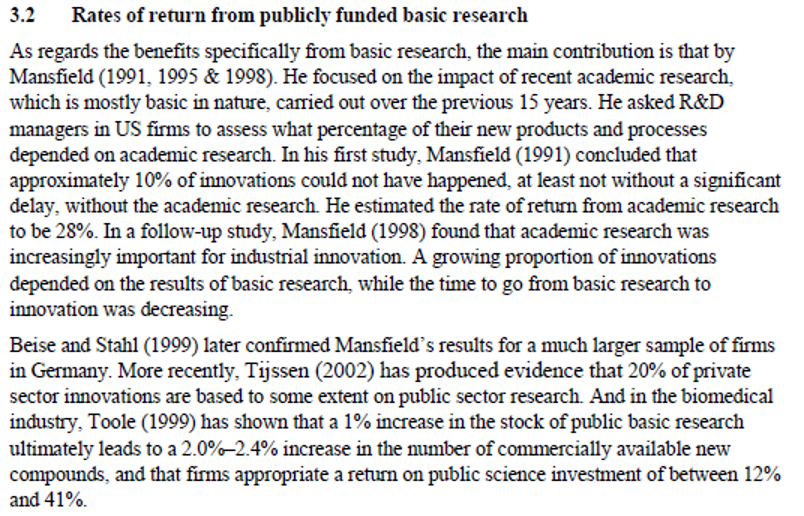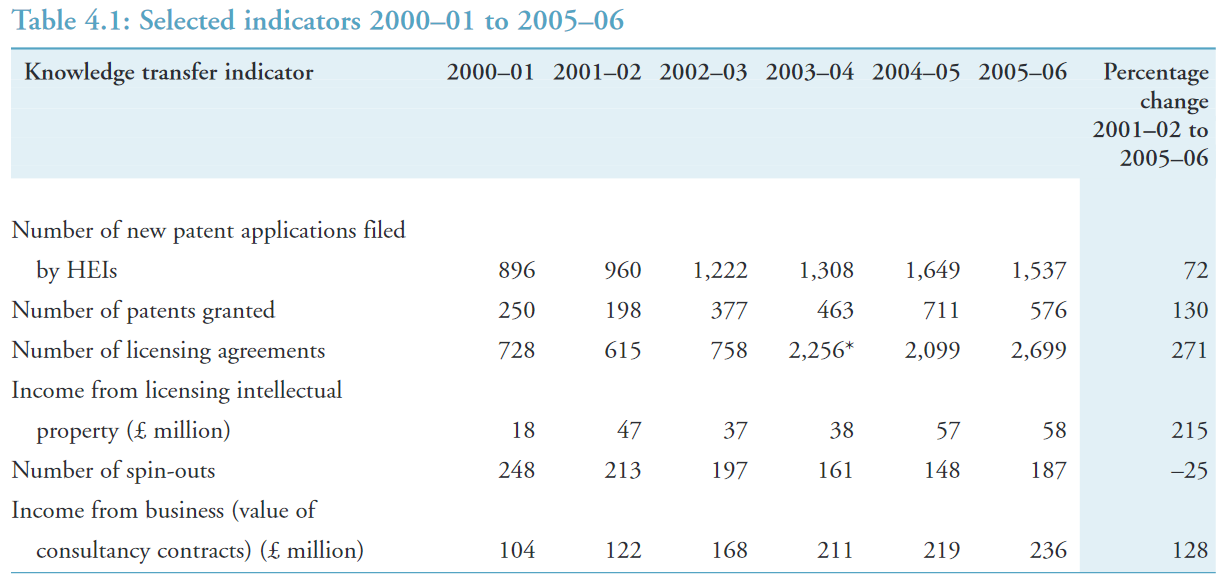Evidence for the utility of funding science as an investment in society
- How science investment has impact
There is much research into what return on the investment can be estimated. There are a variety of ways that a return to society is produced, summarized below: [from a Royal Society report in 2010, http://royalsociety.org/uploadedFiles/Royal_Society_Content/policy/publications/2010/4294970126.pdf].
[from a Royal Society report in 2010, http://royalsociety.org/uploadedFiles/Royal_Society_Content/policy/publications/2010/4294970126.pdf].
- A typical quote from a study is B Martin and P Tang (2007) [http://www.sussex.ac.uk/spru/research/sewps#2007] on ‘The benefits from publicly funded research’ (SPRU working paper 161, Science and Technology Policy Unit, University of Sussex):
 This implicitly highlights many of the problems of attempting this sort of attribution.
This implicitly highlights many of the problems of attempting this sort of attribution.
– what came from research progress compared to many other input factors involved?
– how research in one country benefits many other countries?
– funding public research gives quicker breakthroughs than would happen otherwise, but how to quantify the change in growth rate, and how to discount this over time?
– how to deal with the long times involved (it can take 10-25years to benefit in technology, and when should we count that the investment was needed, from latest to earliest possible chains of causation)?
As they suggest
For instance, Bowns (2003) [http://www.rvm.gatech.edu/bozeman/rp/read/21801.pdf] suggests that although government measurement laboratories do generate some income, since this is in fact foisted on their industries, overall it may not be not helping them directly.
Toole (1999) [http://www.stanford.edu/group/siepr/cgi-bin/siepr/?q=system/files/shared/pubs/papers/pdf/00-07.pdf] looks at the pharma industry, and found it hard to control for the generally increasing stock of knowledge anyway worldwide (not just in the USA). They also find an average 18yr lag between discovery and translation. They suggest that an investment of $125M in 1974 (in US1986$) by 1993 would deliver only one new successful drug. The total cost of each new drug (from private funding) is $500-750M, and urged caution for attribution since exactly this investment in public research is generally helpful.
- Spillover evidence
This discussion looks at where public R&D specifically boosts local industry, and how. One way it can operate is to develop a local stock of science-trained people (giving improved local tacit knowledge). Studies shows 75% of USA patents cite public funded research, but it is unclear if these are to the key breakthroughs, or previous incremental steps (citations in such documents could be greatly improved to understand how critical they are on the path to a new patent). Hicks and Olivastro (1998) [here] in a useful report show that patents do tend to cite local universities. They used USA company patents 1993-7 (which will thus include university spinoffs, and their references to local university papers). Some states dominated (eg California).
In-state cites are 4 times more likely than expected (excluding here self-cites of companies on scientific papers), but including researchers spinning out (which does not benefit existing industry). It also says nothing about the financial return from these patents, or the areas they are in. Interestingly, in information technologies, patents tend to reference more recent patents and older papers (suggesting that there is no linear tech cycle of research to translation) with few references to the published literature. Universities appear increasingly entrepreneurial, but citations to their patents have dropped (so perhaps their impact is dropped as they focus on patenting more, rather than more breakthroughs of note being protected).
- Catch-up between countries
Griffith (2004) [http://eprints.ucl.ac.uk/4074/1/4074.pdf] suggests that countries can catch up fast in industrial technology if they invest in R&D. It suggests the rate of catch-up depends on distance to the research frontier, so the furthest behind do best if they invest (best improvement in technical efficiency/productivity). It concludes (at least in the USA) that the rate of return to R&D on (all) R&D is 43% (though it is unclear how this breaks down, for instance for basic R&D) through direct linear innovation. It is not clear if this suggests how technological breakthroughs feed back into science. They comment that ‘Thus R&D has played a role in the convergence of productivity (TFP) levels within industries across OECD countries’. They also suggest that firms rely heavily on open publications to understand an area.
- The free-rider problem
This is discussed further in an EU report [http://discutii.mfinante.ro/static/10/Mfp/buget/reformabugetue/5bStudyEUspendingen.pdf, p119],“Van der Horst et al. (2006) show that the openness of a country tends to be negatively related to government expenditure on public and private research. This suggests that the free-rider problem caused by knowledge diffusion is a real-world problem.”
“Knowledge, the product of research, is non-rival and often also non-excludable. For the same reasons as the nonrivalry and non-excludability of knowledge leads to market failure, it may result in government failure if knowledge diffuses freely across borders. In this situation, a part of a nation’s expenditure ‘leaks away’ to other countries and gives national governments an incentive to ‘free-ride’ on the research funded abroad (Pelkmans, 2006b).”
- quality vs utility
Most of us in the university sector have believed firmly that as long as quality is kept high, as long as principal investigators are decently supported and permitted to follow their own noses, quality will beget discovery, and utility will probably follow. This notion, sometimes called the Columbus theory of research, is actually much older than most people think it is. The eighteenth-century mathematician and physician d’Alembert says in the introduction to Diderot’s Encyclopedia of Science: “Another motive serves to keep us at such work: utility, which, though it may not be the true aim, can at least serve as a pretext. The mere fact that we have occasionally found concrete advantages in certain fragments of knowledge, when they were hitherto unsuspected, authorizes us to regard all investigations begun out of pure curiosity as being potentially useful to us.” He understood grantsmanship before there were grants.
from The Positive Sum Strategy: Harnessing Technology for Economic Growth, Nathan Rosenberg, Ralph Landau [National Academies Press, 1986, book]. In another section, they discuss
CONSIDERATIONS IN FORMULATING RESEARCH POLICIES: The issue of the relationship between quality and utility in basic research is a difficult one, chiefly because it involves attempting to define policy for a realm of activity that no one understands. Science has produced enormous gains for this society, but even when we employ so restrictive a definition of scientific progress as to measure only intellectual (and not technological) outcomes, we have great difficulty in discovering what makes it work. For example, does progress depend primarily on the contributions of a few extraordinary individuals or is it the cumulative result of smaller efforts by a larger number of workers? Even so basic a question is hard to answer. The formal analysis of research productivity seems to show disproportionate contributions by a relatively small number of scientists, and the histories of disciplines always focus on a few giants. But retrospective examinations of many modern advances reveal a complex web of precursor influences in which dozens of workers have played essential roles. I do not believe that it is possible at this time to generate a hypothesis about the distribution of significant work that would be of much use in formulating research policy. Nor do we know how the presence of directive forces affects the research enterprise. Does utilitarian influence have a negative impact on quality? It is widely believed among basic researchers today that it does but in the last century splendid science flourished under industrial sponsorship.
From this comes ideas of a `knowledge bank’ from funded science, against which society can draw.
- More trenchant criticism comes from Levine in “why entreprenurial universities are not engines for local economy” [http://media.journalinteractive.com/documents/levine-100409.pdf]. For instance, studies by Shapiro (2006) on the effect on the local economy [http://faculty.chicagobooth.edu/jesse.shapiro/research/history.pdf] look at the data showing “from1940 to 1990, a 10% increase in a metropolitan area’s concentration of human capital was associated with a 0.8% increase in the area’s employment growth“. They show that 0.5% of this increase was related to more college graduates (ie. human capital) improving productivity growth. Shapiro explicitly discusses “academic capitalism“, a more direct effect from universities. The idea being that patenting returns seed more spinouts. However it is unclear if return to the university is in terms of profile instead of profit, jobs and training instead of manufacturing. There are only a few success stories, and most universities lose money on tech transfer: 30% generate a bit, and only 5 in the USA do very well (based on drugs and techniques).
- A further study (Hill, 2006) suggests:
The economic effects of university research are “discernible and statistically significant,” but “skewed and modest.” These impacts are likely to occur “when faculty are on the cutting edge of revolutionary commercial technologies, when graduate programs in science and engineering are top notch, and when the university is located in a large urban area with an existing concentration of industrial R&D and high tech production. These conditions are difficult to replicate”
Perhaps the best idea to take away is that we grow technologists, but we need places for them – they are hard to seed on barren ground (ie. where there is no already existing set of relevant industries to take up their knowledge).
- A 2007 UK study tried to estimate the direct return to UK universities from their IP licensing (which has not been going as long as in the USA) [http://www.hm-treasury.gov.uk/d/sainsbury_review051007.pdf]. By 2006 this was still only £60M/yr, which is rather small given the number of patents and spinouts:
